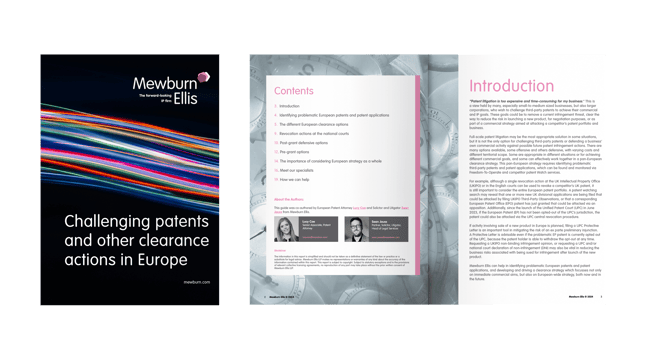
Whether it is to remove a current infringement threat, clear the way to reduce the risk in launching a new product, for negotiation purposes, or as part of a commercial strategy aimed at attacking a competitor’s patent portfolio and business, there are many reasons why a business may want to challenge a third-party patent or defend their own business activity against possible future infringement actions. However, it is important to remember that full-scale patent litigation is not the only option, or necessarily even the most appropriate option, for doing so in order to achieve your commercial or IP goals.
There is a range of different options and strategies to maximise your outcomes
There are many options available, some offensive and others defensive, with varying costs and different territorial scope. Post-grant offensive options include European Patent Office (EPO) oppositions, UK Intellectual Property Office (UKIPO) non-binding validity opinions, and revocation actions at the UKIPO, UPC or national courts. Post-grant defensive options include UPC protective letters, UKIPO non-binding infringement opinions, and UPC or national court declarations of non-infringement (DNIs). Pre-grant options include third-party observations at the EPO, UKIPO, German Patent Office (DPMA), and at the World IP Office (WIPO). These options are appropriate in different situations and to achieve different commercial goals, and they can each, in suitable situations, be used in isolation to attack a third-party European patent or patent application or to defend a business’ own activity against future claims of infringement. However, they can also work even better in combination, as part of a pan-European offensive strategy.
For example, if litigation is ongoing before the English courts, it is important to watch family members of that UK patent. If there are corresponding EP patent applications, Third-Party Observations could be filed at the EPO, and similarly, for any UK divisional patent applications, Third-Party Observations could be filed at the UKIPO. An EPO opposition could be filed with respect to any recently granted EP patents, and if an EP patent is not opted-out of the UPC, a UPC revocation action could be filed either alongside an EPO opposition, or even afterwards if the opposition is unsuccessful in completely revoking the patent.
UPC Protective Letter is an important tool
If activity involving sale of a product is planned or already underway in Europe, filing a UPC Protective Letter is an important tool in mitigating the risk of an ex parte preliminary injunction. A Protective Letter is advisable even if the EP patent is currently opted out of the UPC, because the patent holder is able to withdraw the opt-out at any time. Requesting UKIPO non-binding infringement opinions, and DNIs may be vital tools
The ultimate aim is to align your choice with your commercial and IP goals
Whether or not to go ahead with each of these different options, when, and which combination is best, will of course depend on the specifics of the case.
Taking a step back from a specific action, and instead considering the pan-European strategy as a whole, is a good way to efficiently and cost effectively identify and reduce the risks associated with problematic patents or patent applications in a competitor’s European patent portfolio. This is because, in Europe, actions can run concurrently, many procedures do not estop each other, and arguments and evidence can be reused. Additionally, by appropriately selecting which actions to take and when can apply meaningful pressure to competitors at the appropriate time in order to encourage a commercial resolution or settlement.
We handle all aspects of litigation at the UPC, both offensive and defensive actions
Mewburn Ellis has great experience in representing clients in all of the actions and options set out above. We have strong connections with colleagues in other jurisdictions in Europe, so that we can successfully manage coordinated and cohesive parallel multi-jurisdictional actions throughout Europe to maximise leverage and outcomes. Our attorneys are valued for their ability to take a step back and, based on the commercial and business aims of our clients, to consider, develop and drive a pan-European clearance strategy, which takes into account both present and future risks, as a whole.
|
|
New Brochure:
|
Lucy is an experienced UK and European Patent Attorney and UPC representative specialising in physics and software, and with a specific focus on contentious work and litigation. Her deep knowledge and expertise in the vast array of options for challenging patents in Europe allows Lucy to advise her clients on a pan-European patent litigation strategy, centred on balancing the options available to achieve their commercial goals.
Email: lucy.coe@mewburn.com
Subscribe to Mewburn Ellis Forward
Our people
Our IP specialists work at all stage of the IP life cycle and provide strategic advice about patent, trade mark and registered designs, as well as any IP-related disputes and legal and commercial requirements.
Our peopleContact Us
We have an easily-accessible office in central London, as well as a number of regional offices throughout the UK and an office in Munich, Germany. We’d love to hear from you, so please get in touch.
Get in touch


.png)
